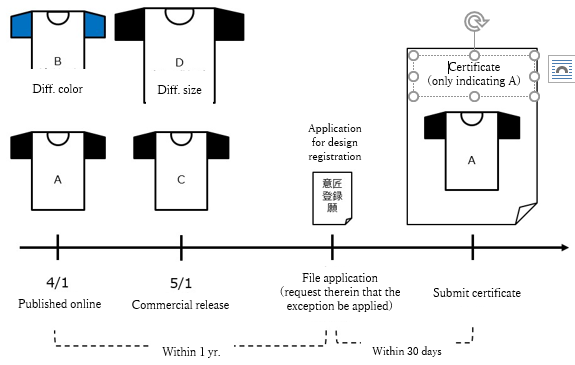(Designs/Japan) Promulgation of Law that Partially Amends the Unfair Competition Prevention Act, etc. (Relaxation of Procedures for Exception to Loss of Novelty in Designs)
The “Bill for Partial Amendment of the Unfair Competition Prevention Act, etc.” was passed and enacted on June 7, 2023, and promulgated on June 14, 2023.
https://www.jpo.go.jp/system/laws/rule/hokaisei/sangyozaisan/fuseikyousou_2306.html (in Japanese)
Design Act Article 4 was revised therein, resulting in the relaxation of procedures for exceptions to loss of novelty in designs.
Specifically, Design Act Article 4(3) was amended to add the following provision: “however, when there have been two or more acts by persons entitled to obtain design registration that have led to the application of Article 3(1)(i) or Article 3(1)(ii) regarding an identical or similar design, it shall be sufficient to submit a certificate for one of the acts that was carried out on the earliest date, from among said two or more acts.”
This amendment results in the points below changing in practice.
・If the same design is disclosed multiple times (published on a website on April 1 then sold on May 1, for example), a certificate now needs to be submitted for only the earliest act (i.e., April 1 here).
・If multiple similar designs are disclosed (several articles of clothing that are similar overall but differ only in color, size, or detailed specifications, for example), a certificate now needs to be submitted for any one of the designs.

For example, in the case illustrated above, the applicant need only to list A in the certificate because T-shirts A, B, C, and D are considered to be mutually similar.
Previously, when a design was disclosed prior to the filing of an application for a design registration, it was necessary in principle to list all such acts of disclosure in the certificate, which placed a significant burden on the applicant, but this amendment will greatly reduce that burden.
The points below, however, should be noted.
(a) The certificate must be submitted strictly within 30 days from the filing date.
(b) If a design disclosed before the disclosure date indicated in the certificate is found after the permitted period for submitting the certificate has passed, it will not be eligible to invoke the provision on exception to lack of novelty.
(c) If a disclosed design that the applicant considered to be similar and did not list in the certificate is found during an examination or trial to be not similar to the applied-for design, the exception cannot be applied to that disclosed design.
Regarding (c) above, one might be inclined to think that “there should be no issue if the disclosed design and the design of the filed application are not similar.” There is certainly no issue with respect to the provisions on novelty (each item of Design Act Article 3(1)) but, in fact, there is some likelihood of issues arising with respect to the ‘ease of creation’ requirement (Design Act Article 3(2)). Whether the cited design and the design of the filed application are similar is not a requirement in the provision on ease of creation, and cases therefore exist where an application may be rejected as being “easy to create” based on a disclosed design to which the exception could not be applied because it was determined to be not similar.
To avoid this risk, it is advisable to include the disclosed design in the certificate unless it can be clearly determined that the disclosed design is similar to the design of the filed application.
It should be noted that the effective date of this amendment is established to be within a period not exceeding nine months from the promulgation date.
